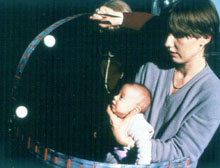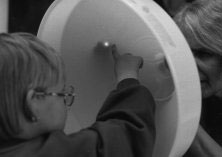Visual Field Tests
I have no commercial tests for visual field of my own design although I have for years studied possibilities to assess how we see motion related information in our visual field and whether it is present in scotomas measured with routine clinical perimetric techniques. It has been far more difficult than expected to simplify the measurements so that they are acceptable for clinical use. Some preliminary results are reported in my lectures. Our findings have shown that the present clinical perimetric tests do not give a correct picture of visual field in a number of conditions. This is important to keep in mind when assessing functional vision.
Visual field measurements are of two basic types: 1. measurement of the extent of the visual field and 2. assessment of the quality of the central visual field.
 Sheridan's bolls on stick can be used in perimetric studies. In reseach laboratories the measurement of the angle and the meridian can be made very exactly by using dark arch perimetry as in this picture, where Gesine Mohn supports the baby during the measurement.
Sheridan's bolls on stick can be used in perimetric studies. In reseach laboratories the measurement of the angle and the meridian can be made very exactly by using dark arch perimetry as in this picture, where Gesine Mohn supports the baby during the measurement.
Measurement of the extent of the visual field is done with confrontation techniques using finger movements, balls of different size on thin sticks or specific grating or dot targets (ViceVersa) on one side and a grey target on the other side of the visual field of the child.
Infants and young children can be examined with the Nef perimeter, a simple funnel like instrument in front of the child. The examiner's eye looks through the hole and is an effective fixation target for central fixation. When a small flash light is placed close to the funnel the child shifts gaze to the light if it was seen. Young infants lay on their back and the funnel is kept above them.
 Rosemarie Nef-Landolt observes shifts of fixation when a small light is presented in
peripheral parts of the Nef funnel. In this case the child also points to the light.
Quite young infants can be examined using this simple technique.
Rosemarie Nef-Landolt observes shifts of fixation when a small light is presented in
peripheral parts of the Nef funnel. In this case the child also points to the light.
Quite young infants can be examined using this simple technique.
In the examination of older children Damato campimeter is used to detect small scotomas in the central visual field.
Very small scotomas may be found only by asking the child whether any of the letters of the text are distorted or vanish in certain font sizes.
Paediatric Vision Tests I Vision Tests I Instructions Section I Main Page